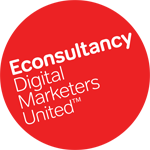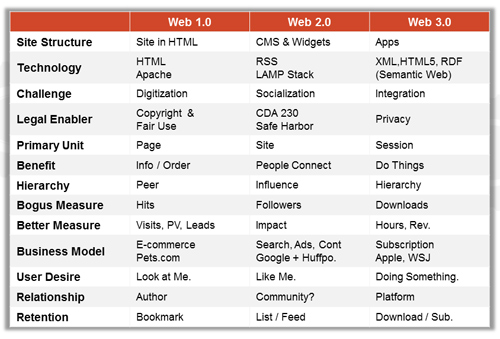Live From London: The Future of Digital Marketing – Mobile Marketing Data
 Imaging writing a blog like this about the Future of Digital Marketing, and then discovering that hundreds of the best brand marketers in Europe are getting together for a conference with that exact title. So, this week I’m in London visiting with agencies and brands about the future of their digital businesses. Thanks to everyone at eConsultancy for bringing me in, and for making it fun.
Imaging writing a blog like this about the Future of Digital Marketing, and then discovering that hundreds of the best brand marketers in Europe are getting together for a conference with that exact title. So, this week I’m in London visiting with agencies and brands about the future of their digital businesses. Thanks to everyone at eConsultancy for bringing me in, and for making it fun.
For someone to be credible talking about the future, they need to have a good view of the trajectory of the present. So, this presentation has extra data in it, which I hope delegates will use in making their business case to create mobile and application experiences. To relieve delegates from writing down my facts and figures and to let them process my talk, I’m posting my deck along with some notes on the facts and figures which are part of my talk track.
I’m also posting the this chart which drills down on how each phases of web development, and links to resources that have proven to be helpful in thinking about Web3.0 , the post PC era, the mobile shift, or what every you call this online transition we’re all a part of today.

If you’ve not heard the talk, then my PowerPoint deck will leave you connecting themes yourself. This is because my presentation decks are illustrations of my talks, rather being an alternative to them. However, if you have questions drop me a note, or speak with me. I’m glad to fill in the lines.
Data which I mentioned which isn’t on the slides.
Text Messaging is Still a Huge Opportunity
SMS Adoption: SMS messaging has tripled over the last four years. There are now 200,000 text messages sent per second, resulting in $14,000 of revenue to telecomes per second. This is a substantial sources of telecom income, making up over 12% of revenue for china’s largest telecom provider. (Source: ITU, December 2010).
Text messaging has reached a tipping point in the US, this year the number of text message will exceed the number of phone calls placed. According to Neilsen, US teens send 23 times more text messages than phone calls, and all age segments up to age fifty send more texts than calls.
Text messages are effective. Calvin Kline has used text messaging in campaigns resulting in click throughts ranging from 5% (which would be a credible email result) to 25%.
Shift from to PC’s and the Rise of Mobile Only
The shift from the PC to mobile devices is historic. This is the first time in thirty years that the WinTel platform has lost market share to competitors.
This is ushering in a new significant audience segment which uses “mobile only”. Besides the data I share from Cisco in the presentation, I note that Pandora currently gets 40% of its use from audience members who only use them with their mobile devices. Increasingly digital strategy must begin at mobile.
Size of Mobile and App Market Opportunity
On Mary Meekers tech adoption chart I often note that in 2006 17% of pages in Japan were served to mobile devices. Today 84% of pages in Japan are viewed on mobile, with only 16% remaining on PCs.
Gartner predicts app sales will top $$150bn by 2015. That’s comparable to GE which has revenue of $157Bn.
Starbucks crops up twice in my presentation. In the US one in five customers pay for their purchases using the firm’s smart card. One third of their customers own smart phones. Payment by phone, such as with NFC, in clearly on their growth path. I also later note that Starbuck’s Facebook page gets 12x times the traffic that their brand website receives. This shows how audience platforms are reducing the emphasis on corporate websites.
Here’s where to get further information on what the shift to mobile and apps means to marketing
Digital Strategy
- eConsultancy Internet Statistics Compendium, May 2011
- ChiefMarTec: Blog on Fitting Technology and Marketing Leadership Together
- UsefulArts.us
Web3.0
- Kate Ray’s Web3.0 Video
- Web3.0 Everything Becomes Everything Else
- Ned May, Outsell Mobile and Tablet Research Nov. 2010
Shopping for Low Priced App Makers?
- (Behance & Dribble, Forrst)
- TheyMakeApps.com, GetAppsDone.com, odesk.com
A fine read on the process of planning and managing app development.

 The future of digital experiences will be built by strategists who grasp the full array of emerging business, social, and technical models. Specialties in user experience, branding, application design, and data science are laying the foundation for richer user experiences and business models breakthrough products and revenue based marketing.
The future of digital experiences will be built by strategists who grasp the full array of emerging business, social, and technical models. Specialties in user experience, branding, application design, and data science are laying the foundation for richer user experiences and business models breakthrough products and revenue based marketing.
8 Responses to "Live From London: The Future of Digital Marketing – Mobile Marketing Data"
June 18, 2011
[…] Taken from: Live From London: The Future of Digital Marketing – Mobile … […]
June 24, 2012
[…] Dope Slap Social Business Needs?On stage at the Future of Digital Marketing in London I called her one of the most astute practitioners of social media anywhere. Nobody tells you at the career office at college to go be a mute statue in Harvard Square. Can you […]
October 31, 2016
[…] 2011 conference topics were fairly tech-focused. The two topics that brought me to London were: “Is Mobile Really Going Shift the Digital World, How?” and “What is the Future of Messaging?” These really started with a technical hypothesis, and […]
December 17, 2019
[…] The Future of Digital Marketing conference in London. The organizers warned that my talk on how the era of mobile would drive change might get a skeptical reception. And that prediction didn’t fail: a few attendees described […]
September 1, 2020
Visit – ficken im bad – for your own free sexy chat experience!
February 10, 2022
I thin the future of digital marketing lies in the green energy sector. To learn more about green energy and solar panels click here. It’s an amazing part of our future because it sells itself.
March 15, 2023
nice
March 15, 2023
great